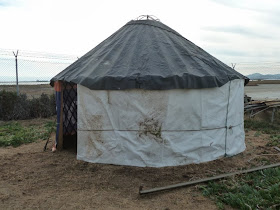But first, some outside views of the sixteen foot yurt with a skin on it. This skin consists of big plastic banners that have done their duty. They consist of a fabric substrate that is then coated with some sort of plastic. On this, the graphic is printed. And when the date for the advertisement expires, they are tossed or handed off to some recycler. I got these from my friend Tim who got them from a neighbor. So yes, they're recycled.
As I said, this is a test, the 16 foot yurt being a prototype for all aspects of the yurt technology. So far the test of the banners as a covering material has gone on for about a year. I have already been using the banners as a cover for my kayaks. What I found out is that the plastic deteriorates within a year, probably at the same rate as those ubiquitous blue tarps sold everywhere. So I would probably use these plastic sheets only for temporary installations. The amount of work to do a good job on covers isn't worth it given the short life of this stuff. Still, for prototyping, they are just fine. Beside the short lifetime of the banners, another major shortcoming is that they are heavy and stiff, especially in cold weather and getting them installed is quite a chore, especially for the roof. The walls are not a problem. There the stiffness is an asset. Plus you have to not be put off by whatever commercial message is printed on the banners.
And now for the fire test.
 |
| The fire in progress with a bucket of water standing by just in case. |
Also, this yurt is quite tall with 64 inch high walls and the smoke hole at about 10 feet elevation. So this is a fair size space to dissipate the smoke. So for now, recommendations are, keep the sticks small to minimize smoke. Get the fire going good and hot before you invite anyone inside the yurt, ideally, you would build up a good bed of embers first so any new wood on the fire would burn quickly without a lot of smoke.
Or get a stove. I ordered one and will report on that soon as I get it.
 |
| Shortly after sunset with some color remaining in the sky and the San Francisco skyline in the background and the tail end of Alameda in the foreground just past the yurt. |



No comments:
Post a Comment